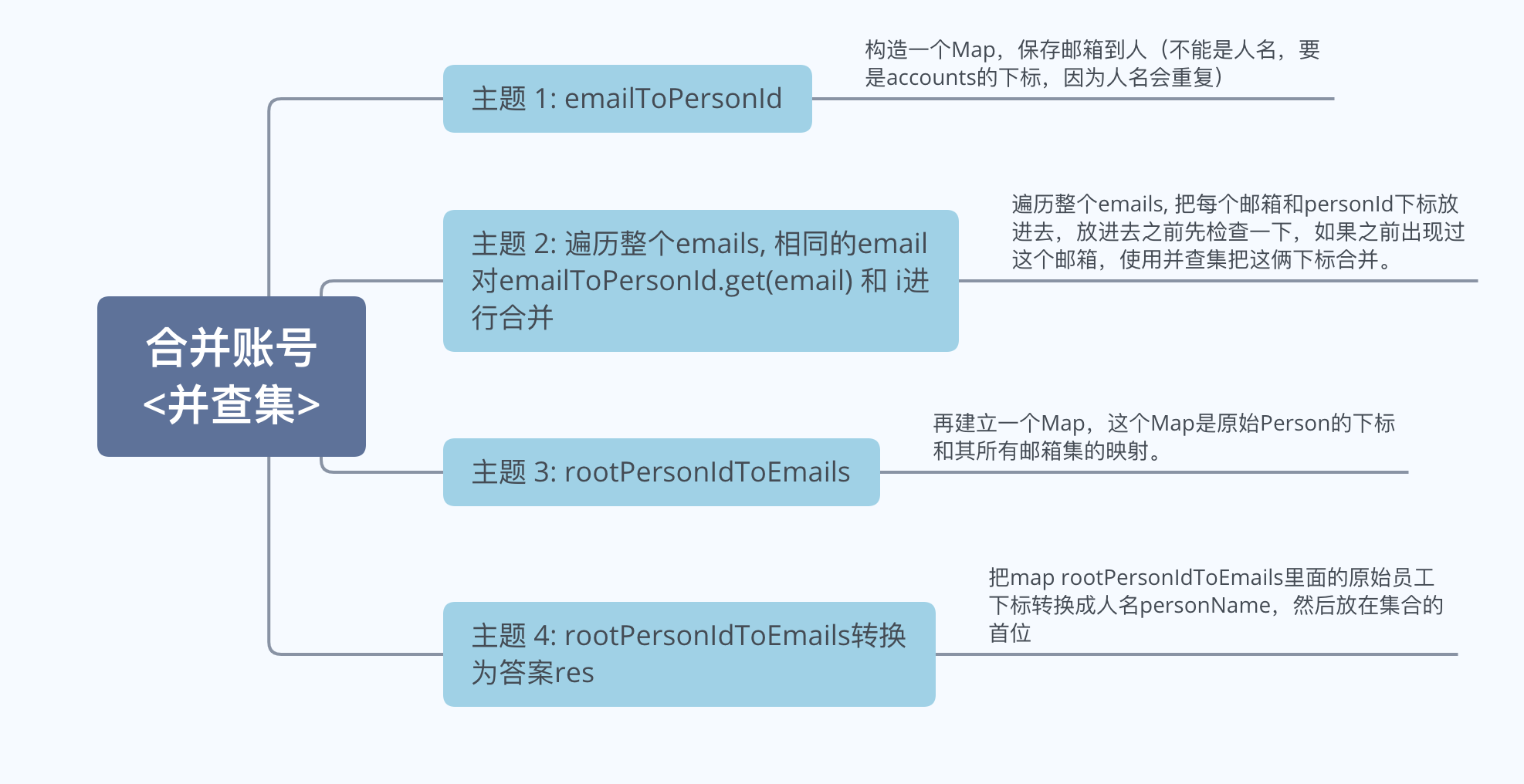题目描述
给定一个列表 accounts,每个元素 accounts[i] 是一个字符串列表,其中第一个元素 accounts[i][0] 是 名称 (name),其余元素是 emails 表示该帐户的邮箱地址。
现在,我们想合并这些帐户。如果两个帐户都有一些共同的邮件地址,则两个帐户必定属于同一个人。请注意,即使两个帐户具有相同的名称,它们也可能属于不同的人,因为人们可能具有相同的名称。一个人最初可以拥有任意数量的帐户,但其所有帐户都具有相同的名称。
合并帐户后,按以下格式返回帐户:每个帐户的第一个元素是名称,其余元素是按顺序排列的邮箱地址。accounts 本身可以以任意顺序返回。
样例
Input:
accounts = [["John", "johnsmith@mail.com", "john00@mail.com"], ["John", "johnnybravo@mail.com"], ["John", "johnsmith@mail.com", "john_newyork@mail.com"], ["Mary", "mary@mail.com"]]
Output: [["John", 'john00@mail.com', 'john_newyork@mail.com', 'johnsmith@mail.com'], ["John", "johnnybravo@mail.com"], ["Mary", "mary@mail.com"]]
Explanation:
第一个和第三个 John 是同一个人,因为他们有共同的电子邮件 "johnsmith@mail.com"。
第二个 John 和 Mary 是不同的人,因为他们的电子邮件地址没有被其他帐户使用。
我们可以以任何顺序返回这些列表,例如答案[['Mary','mary@mail.com'],['John','johnnybravo@mail.com'],
['John','john00@mail.com','john_newyork@mail.com','johnsmith@mail.com']]仍然会被接受。
注意:
accounts的长度将在[1,1000]的范围内。
accounts[i]的长度将在[1,10]的范围内。
accounts[i][j]的长度将在[1,30]的范围内。
算法
(并查集)
思路图:

有思路图就不展开细讲,主要是并查集合一定要会默写。
时间复杂度 O(nlogn)
Java 代码
class Solution {
public List<List<String>> accountsMerge(List<List<String>> accounts) {
int size = accounts.size();
List<List<String>> res = new ArrayList<>(size);
if (size == 0) {
return res;
}
UF uf = new UF(size);
Map<String, Integer> emailToPersonId = new HashMap<>();
for (int i = 0; i < size; i++) {
List<String> account = accounts.get(i);
for (int j = 1; j < account.size(); j++) {
String email = account.get(j);
if (emailToPersonId.containsKey(email)) {
Integer prePersonId = emailToPersonId.get(email);
uf.union(prePersonId, i);
}
emailToPersonId.put(email, i);
}
}
Map<Integer, Set<String>> rootPersonIdToEmails = new HashMap<>();
for (int i = 0; i < size; i++) {
int rootPersonId = uf.find(i);
List<String> emails = accounts.get(i).subList(1, accounts.get(i).size());
if (rootPersonIdToEmails.containsKey(rootPersonId)) {
rootPersonIdToEmails.get(rootPersonId).addAll(emails);
} else {
rootPersonIdToEmails.put(rootPersonId, new TreeSet<>(emails));
}
}
for (Map.Entry<Integer, Set<String>> entry : rootPersonIdToEmails.entrySet()) {
List<String> sub = new ArrayList<>();
int rootPersonId = entry.getKey();
String name = accounts.get(rootPersonId).get(0);
sub.add(name);
sub.addAll(entry.getValue());
res.add(sub);
}
return res;
}
}
class UF {
int[] parent;
int[] rank; // 表示i为root的集合所表示的高度
public UF(int size) {
parent = new int[size];
rank = new int[size];
for (int i = 0; i < size; i++) {
parent[i] = i;
rank[i] = 1;
}
}
public int getSize() {
return parent.length;
}
// 查找元素p对应的集合编号, O(h)复杂度
public int find(int p) {
if (p < 0 || p >= getSize()) {
throw new IllegalArgumentException("p is out of bound");
}
while (p != parent[p]) {
parent[p] = parent[parent[p]];
p = parent[p];
}
return p;
}
// 元素p和元素q所在两个集合合并,O(h)复杂度
public void union(int p, int q) {
int pRoot = find(p);
int qRoot = find(q);
if (pRoot == qRoot) {
return;
}
// 根据集合高度来判断合并方向
// rank低的合并到rank高的
if (rank[pRoot] < rank[qRoot]) {
parent[pRoot] = qRoot;
} else if (rank[pRoot] > rank[qRoot]) {
parent[qRoot] = pRoot;
} else {
parent[pRoot] = qRoot;
rank[qRoot] += 1;
}
}
// 查看元素p和元素q是否在一个集合
// O(h)复杂度
public boolean isConnected(int p, int q) {
return find(p) == find(q);
}
}


if (p < 0 || p >= getSize()) {
throw new IllegalArgumentException(“p is out of bound”);
}
这个应该不需要吧,从来没看过要扔excetpion的解法